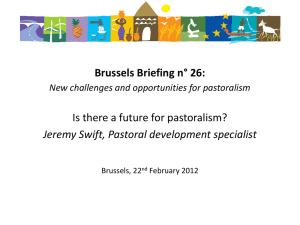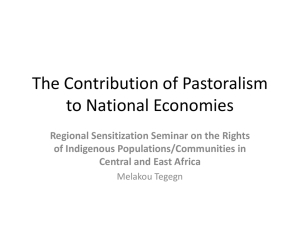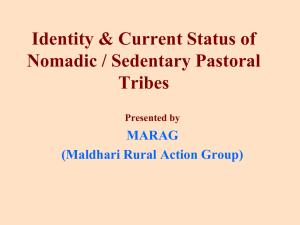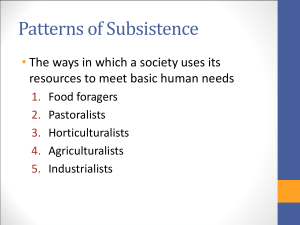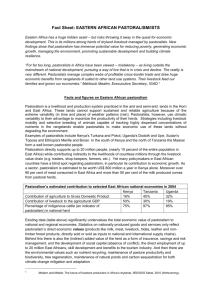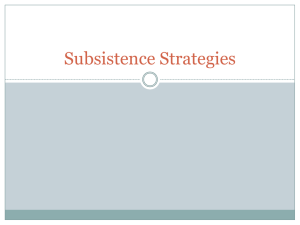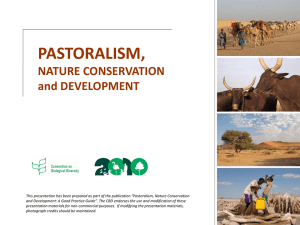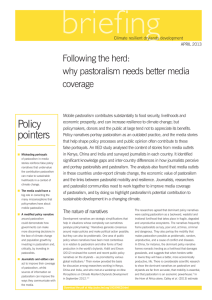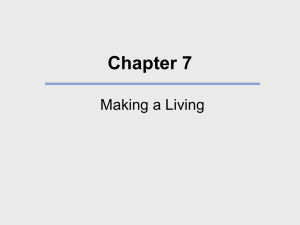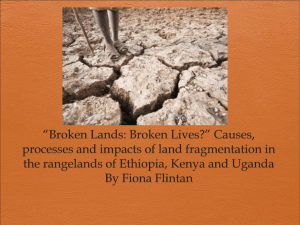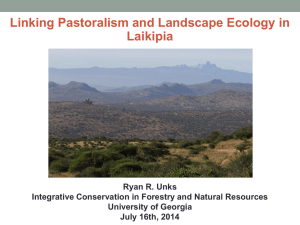PASTORALISM
advertisement
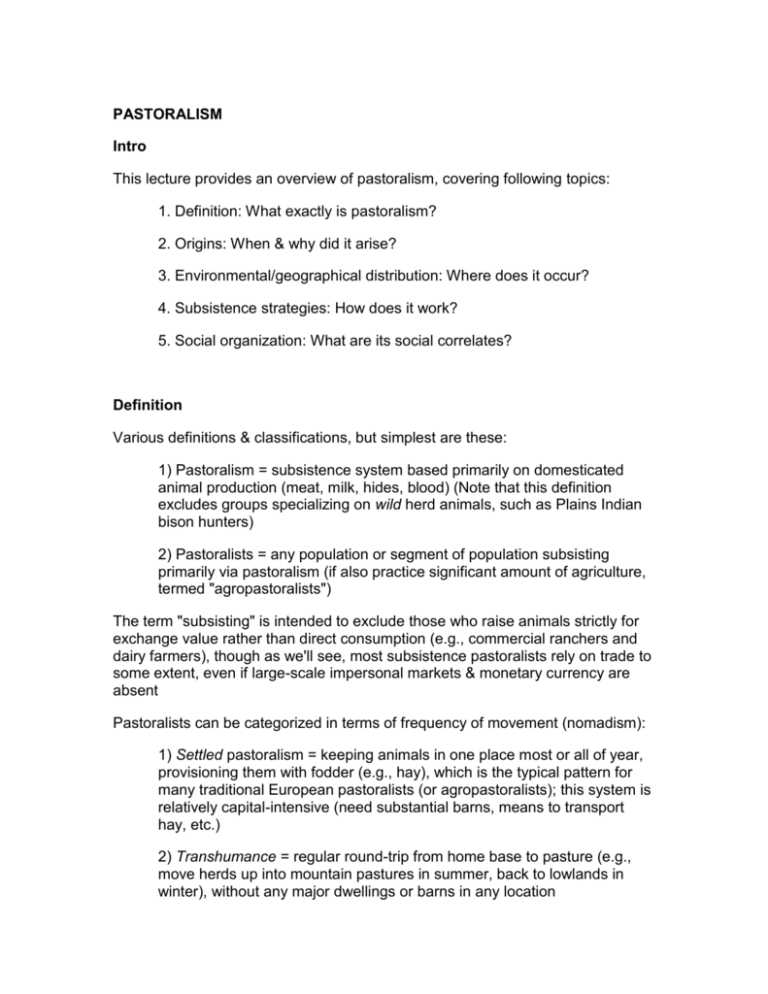
PASTORALISM Intro This lecture provides an overview of pastoralism, covering following topics: 1. Definition: What exactly is pastoralism? 2. Origins: When & why did it arise? 3. Environmental/geographical distribution: Where does it occur? 4. Subsistence strategies: How does it work? 5. Social organization: What are its social correlates? Definition Various definitions & classifications, but simplest are these: 1) Pastoralism = subsistence system based primarily on domesticated animal production (meat, milk, hides, blood) (Note that this definition excludes groups specializing on wild herd animals, such as Plains Indian bison hunters) 2) Pastoralists = any population or segment of population subsisting primarily via pastoralism (if also practice significant amount of agriculture, termed "agropastoralists") The term "subsisting" is intended to exclude those who raise animals strictly for exchange value rather than direct consumption (e.g., commercial ranchers and dairy farmers), though as we'll see, most subsistence pastoralists rely on trade to some extent, even if large-scale impersonal markets & monetary currency are absent Pastoralists can be categorized in terms of frequency of movement (nomadism): 1) Settled pastoralism = keeping animals in one place most or all of year, provisioning them with fodder (e.g., hay), which is the typical pattern for many traditional European pastoralists (or agropastoralists); this system is relatively capital-intensive (need substantial barns, means to transport hay, etc.) 2) Transhumance = regular round-trip from home base to pasture (e.g., move herds up into mountain pastures in summer, back to lowlands in winter), without any major dwellings or barns in any location 3) Nomadic pastoralism = moving herds to any avail. pasture, often on opportunistic basis over long distances and with no fixed pattern; characteristic of populations most dependent on pastoralism, and hence primary focus of this course Origins Under what conditions did pastoralism arise? What favors this specialization? Nineteenth-cent. social evolutionists (e.g., Morgan, Engels) believed nomadic pastoralism was an evolutionary stage between foraging and settled agriculture This seemed plausible, since foragers exercise relatively little control over natural environment and are often highly nomadic; agricultural populations greatly modify environment. and are very sedentary; and nomadic pastoralists are generally intermediate in both regards On average, nomadic pastoralists also intermediate in population density, degree of socio-political complexity, etc. -- hence seem to fit transitional stage of social evolution (between foraging & settled agriculture) quite nicely However, anthropologists no longer believe that pastoralism = widespread intermediate stage between foraging and agriculture, and doubt that pastoralism & animal domestication preceded agriculture and plant domestication Three main reasons for doubting that pure pastoralism precedes agriculture: 1) Difficulty of domesticating animals without some sedentary base and a localized staple food source (though foraging economies sometimes provide both of these) 2) Archaeological record of domestication suggests it occurred in settled communities that also had domesticated plants (though there is some difficulty in clearly detecting initial animal domestication in archaeological record) 3) Virtually no examples in ethnographic record of pastoralist societies that don't depend directly or indirectly (via trade) on agricultural products Main exception to these rules seems to be reindeer herders of No. Eurasia, especially Siberia, where agriculture was absent until very recent (industrial) times; but here it seems that sedentary fishing communities predate reindeer herding, and herders historically depended on trade with these peoples; in addition, reindeer are only slightly domesticated (interbreed freely with wild caribou) Current consensus is that in most cases pastoralists probably arose from "marginalized surplus population" of agriculturalists who for one reason or another lost their land base or abandoned farming, and turned to full-time herding In fact, ethnographers have often observed this process occurring in many areas, where poorer farming strata lose crops in bad year and switch to nomadism, while successful herders often cash in herds to buy land & become settled farmers (though the dynamic can sometimes go the other way: farmers who do well may choose to switch to pastoralism) Environmental/Geographic Distribution of Nomadic Pastoralism What about the geographical and environmental distribution of pastoralism? For nomadic pastoralism, summarized in following table: Geographical Region Ethnic Groups Primary Stock Habitat Type Mid-East/E. Mediterranean (oldest pastoral zone) Turkoman, Baluch, Pathan, Basseri Sheep, goats Hilly, semiarid East Africa & Sahel Maasai, Turkana, Karimojong, Nuer Cattle, goats Dry savannah North Africa & Arabia Bedouin Camels, goats Very arid desert Central Asian steppes Mongols, Kazaks Horses, sheep, camels Rich grassland, severe winters (hay for fodder) Tibetan Plateau Ethnic Tibetans Yaks, horses Arid, low temperature, high altitude No. Eurasian herders Sami (Lapps), Tungus, Chukchi Reindeer Taiga (tundra & boreal forest) Note that these are all areas where agriculture is either not viable, or is very chancy; can conclude from these and other data that pastoralists are generally found in areas where agriculture is unproductive (due to low or patchy rainfall, low temperatures, etc.) Pastoralists use herd animals as "energy converters" to utilize areas outside the margins of agriculture (e.g., camels eat thorny plants of Sahara, llamas eat grasses of altiplano in areas above agricultural zone); thermodynamic consequence of this is that amount of energy produced per unit area is low, since 1) occupying unproductive environments, and 2) subsisting at higher trophic level than agriculturalists In any case, high-density, sedentary populations of pastoralists simply don't occur; it appears that any land capable of supporting this is instead devoted to agriculture This supports inference that in long run, agriculture out-competes pastoralism (either by subsistence choice or by population displacement) in all but most marginal environments In many cases, environments intermediate in productivity seem to favor mixed economy that combines some agriculture with nomadic or transhumant pastoralism (e.g., Karimojong and many other E. African cattle-herders) Subsistence Strategies Pastoralists face complex set of interlocking decisions, concerning: 1) herd species (single or mixed?) 2) herd size & composition (controlled via breeding, culling, exchange, etc.) 3) allocation of available labor force (household or larger kin group) 4) herd movement and pasture utilization (both normal and extreme climatic conditions) 5) mix of pastoralism with other subsistence options (trade, agriculture) Each of these can be studied in great depth; evidence indicates that a wealth of knowledge goes into pastoralist decision making, and understanding these systems has sometimes been hampered by ignorance of researchers, who didn't understand enough about these systems and their determinants to ask herders intelligent questions As a consequence, economic rationality of pastoralists has all too often been misunderstood or overlooked by bureaucrats and aid workers In particular, they have questioned pastoralists herd management, claiming they let herds get too large, causing overgrazing Countering this, ecological anthropologists have argued that pastoralist subsistence rationality differs from commercial-ranching rationality, as follows: a) Pastoralists keep large herds (above economic "optimum") because: 1) storage and marketing not major possibilities 2) they seek to maximize number of people supported on day-to-day basis, not profit or seasonal yield (subsistence logic vs. market logic) 3) usually subsist on dairy products & blood, not meat; this minimizes storage costs and food-income fluctuations 4) large herds = hedge against catastrophic losses (disease, drought), as well as wealth that can be converted into variety of goods (particularly bride-price = gift groom's family must make to bride's family in many pastoralist economies) b) Lack of overt "conservation ethic" regarding pasture land makes sense because: 1) pasture productivity has low spatiotemporal predictability 2) tribal control over grazing lands is often temporary or unstable 3) large fluctuations in human & stock populations due to disease or climate allow pastures to recover periodically Because adequate grazing areas are highly unpredictable in time & space, expected form of land tenure = communal rather than individual or family ownership [further discussion of this in session on land tenure] Social Organization Pastoralist societies must solve 2 interrelated problems: 1) articulate herds with their sustaining resources (nutritionally-adequate pasture, water), which requires mobility and intensive informationgathering 2) articulate management and utilization of herds by different members of society, which requires social mechanisms (division of labor, economic transactions, rules of transfer & inheritance, etc.) Resulting organization of labor and social institutions is complex and variable, but as a general rule can say that these represent a compromise, an attempt to balance conflicting needs for flexibility & control: 1) flexibility needed to manage herd movements, information-sharing, riskpooling, and aggregation & dispersal of herders across landscape 2) formal institutions needed to control ownership & transfer of wealth (stock, any agricultural land, other wealth goods) as well as adjudicate conflicts Social mechanisms for achieving flexibility are varied, but usually include: 1) sodalities (age-sets, associations, ritual groups, etc. which cross-cut kinship & residence units); 2) well-developed means of information-sharing (visiting networks, meeting places, festivals, etc.); 3) co-operative work units (e.g., "camp clusters" of E. African cattle herders -- temporary associations) Formal social institutions focus on inheritance (kinship/descent systems, usually patrilineal) and marriage (bride-price, transfer of stock between spouses, & between lineages, rules of marriage & residence) Combination of flexibility (to allow herd mobility, deal with unpredictable pasture resources) and formal systems of inheritance and alliance (to control use & transfer of stock) give pastoralist societies their special qualities (though of course each society has unique characteristics depending on local ecological & socioeconomic conditions) East African cattle herders These = best-studied pastoralists in ecological anthropology In E. Africa, altitude & rainfall correlate almost perfectly, with rainfall increasing at higher elevation Another factor is temperature, as this affects water evaporation; in tropics, even areas that have more rainfall than Seattle may have such high evapotranspiration rates that they are quite arid These two factors interact to determine available water and hence plant productivity (e.g., in Kenya, 4500 feet = elevation at which rainfall exceeds potential evaporation rate, and where pastoralism fades out and agriculture takes over) Given altitude/rainfall correlation, pastoralists adjust their annual cycle to put herds in lowest (driest) part of range in rainy season, gradually moving to higher elevations so as to end up at highest elevation at end of dry season Movement decisions are very complex -- must plan for whole year but have many contingency plans, take many variables in to account; hence pastoralists have great need for up-to-date information Information flow is channeled via kinship ties & sodalities (age-sets) Each household has large variety of stock, with minimal # of each (in traditional subsistence regime) being 25-30 cattle, 10 camels, 100 small stock (goats & sheep), & 10-12 donkeys (Note: household = women + children associated with a single adult male; homestead = group of related men + families) Each species has to be handled in certain way: e.g., cattle can be watered every other day, small stock need water every day, camels every 3 days Hence, in dry season, must have several herds & herding parties -- very labor intensive system Altitudinal zonation keeps camps apart for most of year [see Diagram] Hence, nuclear families cannot be economically independent -- simply do not provide enough labor Instead, E. African pastoralists generally organize labor via patrilineal extended family (with polygyny) Daughters married out at young age (patrilocal/virilocal residence), but sons stay with father's homestead until they are 30-40 years old, when 1) father dies and son inherits cattle allocated to his mother at time of her marriage, or 2) father grants son an "advance" on his inheritance, letting him marry and set up his own homestead (This last option only happens if father is very successful, has lots of wives & cattle, and therefore can afford to let oldest sons "bud off" and leave father's labor force as well as reduce his herds)
